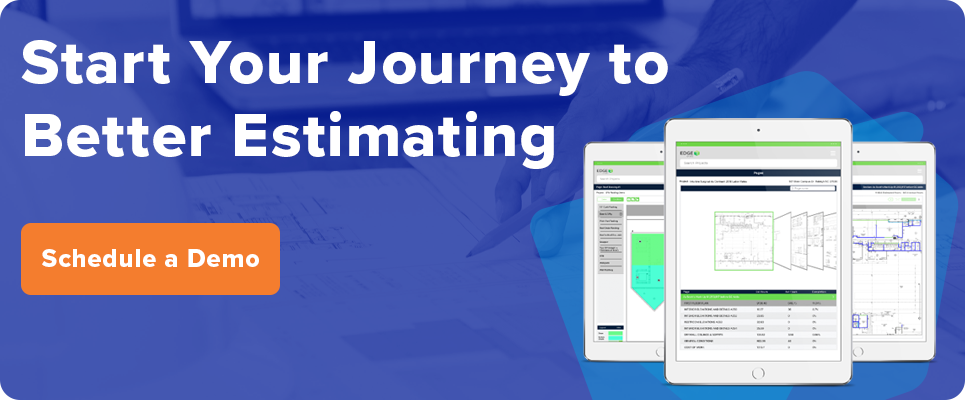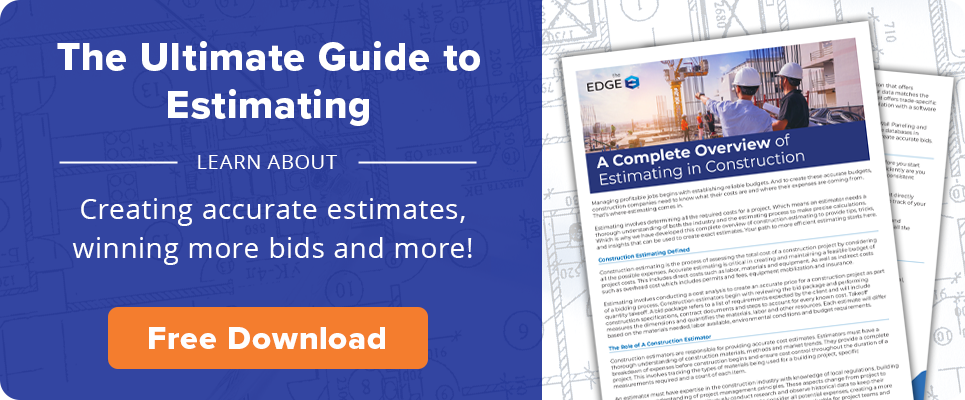
Creating accurate budgets and determining appropriate timelines are crucial steps to managing more profitable jobs. But to get to a place where you’re confident in your data and assured of the competitiveness of your bid you have to understand the various elements involved.
Takeoff, estimates and bids are all included in the preconstruction phase. In their own way, each of these processes are used to determine the schedule and costs for a project. However, as much as they’re independent facets of preconstruction, they’re also heavily dependent on each other. Contractors can’t create accurate estimates if the takeoff performed was defunct. Similarly, bids are directly affected if estimates include faulty pricing.

With so many different steps involved, recognizing why each process is important on a micro and macro level can get confusing. But we’re here to help. In this article, we break down these processes so you can see how everything works together.
Key Takeaways About Construction Estimating Software:
- Construction takeoff refers to measuring the dimensions and quantities of the materials, labor and other resources required to complete a construction project.
- A construction estimate is a complete summary of expenses that equals the assumed total cost of a construction project.
- A construction bid is a formal proposal submitted by a contractor to show how their company would complete a project at a specific price and timeline.
- Using sophisticated construction estimating software to facilitate the estimating and takeoff process helps create more accurate bids.
Construction Takeoff
Takeoff refers to measuring the dimensions and quantities of the materials, labor and other resources required to complete a construction project.
Essentially, takeoff data is when you count the required elements for a project. This takeoff data is compiled to produce quantities for materials, which is important for the pricing process and impacts the accuracy of an estimate.
During the takeoff process, estimators will carefully review architectural and engineering drawings, project specifications and any other relevant documentation to gain a comprehensive understanding of the size of the land/room/building and what items are needed to fit in these spaces.
Construction Estimate
A construction estimate is a complete summary of expenses that equals the assumed total cost of a construction project. It is an itemized cost breakdown that lists a description, quantity, unit cost and total cost for each item.
An estimate typically always includes:
- Project Scope: Determine the goals, constraints, tasks and deliverables of a project by reviewing all the project plans, drawings and specifications.
- Takeoff Calculations: The calculated takeoff helps determine the labor and equipment needs and should always be completed after the project scope is determined.
- Supplier and Vendor Pricing: Each item is assigned specific prices so estimators can determine the cost of each aspect of the project.
- Subcontractor Fees: This is dependent on certain projects but if a subcontractor is hired, the estimator may need to solicit quotes to determine the cost of specifics within the project.
- Contingency: A portion of the budget that is set aside for unexpected costs or possible changes in the project scope.
- Final Estimate: Take the sum of all the costs and provide a detailed breakdown with a list of materials, labor rates and any additional expenses.
Estimates serve as the foundation for the project budget and are used to monitor production as a project is completed. Estimate data can be used to improve budget expenses on similar projects going forward.
Reviewing estimates, change orders, drawings and takeoff documents helps project managers and foremen track inventory, scheduling and cost overruns.
Construction Bid
A construction bid is essentially a formal proposal submitted by a contractor to show how their company would complete a project at a specific price and timeline. A bid acts like an offer, outlining:
- Contractor Information: Identifies the company submitting the bid, including contact details and relevant licenses.
- Project Understanding: Demonstrates the contractor’s grasp of the project scope, specifications and requirements.
- Cost Breakdown: Details the estimated costs for materials, labor, equipment, permits and other project-related expenses.
- Timeline and Schedule: Proposes a realistic timeline for completing the project, outlining key milestones and potential completion dates.
- Qualifications and Experience: Highlights the contractor’s relevant experience, expertise and past performance on similar projects.
- Contractual Terms: Outline the proposed contract terms, including warranty details, liability and dispute resolution procedures.
Winning a bid involves a competitive process, with the owner typically selecting the most qualified and cost-effective proposal.
How Do They All Work Together?
Without takeoff or a detailed estimate, creating an accurate bid is impossible. Typically, construction estimators begin the estimating process with reviewing the bid package, or a list of requirements expected by the client of project specifications and contract documents. Estimators then move into performing quantity takeoff.
After quantifying the materials, labor and other resources, they will design the estimate. The estimate will be used by contractors to nail down a competitive bid, which represents the best quality of service at the most reasonable price.
Estimates can help calculate what materials are needed, how much inventory is required and what manpower is expected. Looking at past takeoff and estimating documents from previous projects help developers adjust processes or repeat successful counts for future projects.
How Does Using Software Help?
Using sophisticated software to facilitate the estimating and takeoff process helps create more accurate bids. The most robust solutions allow you to complete estimating and takeoff in one system, keeping all the required budgeting information on one drawing in one place.
According to InEight, “Many of the significant pain points experienced by estimators, including inaccuracies, frustrations, uncertainties, and a lack of profitability, have been greatly reduced by digitization. Instead, they are finding benefit-rich functionalities to help your business better manage all the details and costs associated with the estimating process.”[1]
The software allows estimators to digitally measure and calculate quantities, automate the pricing process and generate detailed reports and estimates. These tools can streamline the estimation process and improve accuracy and efficiency. With built in templates per trade, estimators can use the software to upload information quickly while building bids.
See How You Can Improve Your Construction Estimating with The EDGE®
Understanding the importance of how takeoff, estimates and bids work together is crucial to analyzing whether your estimating process is effective. And it helps to determine if completing a construction project is even feasible. Taking the time to learn the ins and outs helps you save time and money later.

And if you work in the Acoustical, Drywall, EIFS, Fireproofing, Flooring, Painting, Roofing, Wall Paneling and Waterproofing trades, consider using The EDGE. We offer trade-specific, customizable databases in construction estimating and digital takeoff that have helped thousands of estimators create accurate bids
[1] Tillmon, R. (2022, October 25). The Ultimate Guide to Construction Estimating. InEight. https://ineight.com/blog/construction-estimating/





